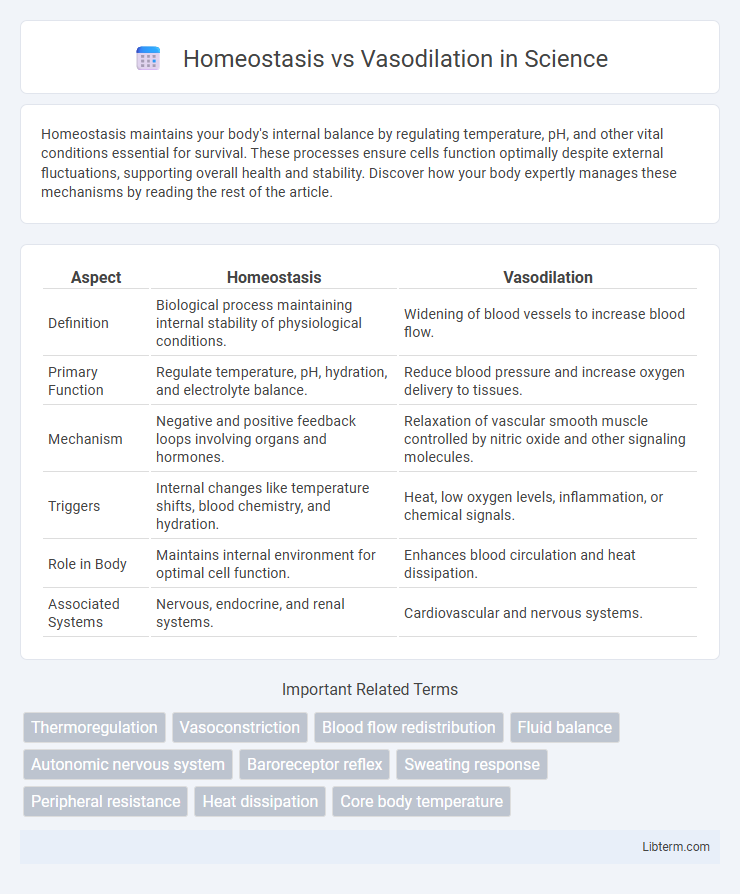Homeostasis maintains your body's internal balance by regulating temperature, pH, and other vital conditions essential for survival. These processes ensure cells function optimally despite external fluctuations, supporting overall health and stability. Discover how your body expertly manages these mechanisms by reading the rest of the article.
Table of Comparison
| Aspect | Homeostasis | Vasodilation |
|---|---|---|
| Definition | Biological process maintaining internal stability of physiological conditions. | Widening of blood vessels to increase blood flow. |
| Primary Function | Regulate temperature, pH, hydration, and electrolyte balance. | Reduce blood pressure and increase oxygen delivery to tissues. |
| Mechanism | Negative and positive feedback loops involving organs and hormones. | Relaxation of vascular smooth muscle controlled by nitric oxide and other signaling molecules. |
| Triggers | Internal changes like temperature shifts, blood chemistry, and hydration. | Heat, low oxygen levels, inflammation, or chemical signals. |
| Role in Body | Maintains internal environment for optimal cell function. | Enhances blood circulation and heat dissipation. |
| Associated Systems | Nervous, endocrine, and renal systems. | Cardiovascular and nervous systems. |
Understanding Homeostasis: The Body’s Balance Mechanism
Homeostasis maintains the body's internal equilibrium by regulating factors like temperature, pH, and fluid balance, ensuring optimal cellular function. Vasodilation plays a crucial role in this process by widening blood vessels to increase blood flow, thereby helping to dissipate heat and lower body temperature. This dynamic adjustment in vascular tone exemplifies how the body preserves homeostasis through cardiovascular and thermoregulatory mechanisms.
What is Vasodilation? Definition and Function
Vasodilation is the physiological process where blood vessels widen due to relaxation of the muscular walls, particularly in arteries and arterioles. This mechanism increases blood flow and decreases blood pressure, playing a critical role in regulating body temperature and promoting oxygen and nutrient delivery to tissues. It is a key component of homeostasis, maintaining internal balance by adjusting vascular resistance in response to various stimuli.
Key Differences Between Homeostasis and Vasodilation
Homeostasis is the body's process of maintaining internal stability across various physiological systems, while vasodilation specifically refers to the widening of blood vessels to increase blood flow. Homeostasis involves multiple regulatory mechanisms such as temperature control, pH balance, and glucose levels, whereas vasodilation primarily affects cardiovascular dynamics by reducing vascular resistance. The key difference lies in scope: homeostasis maintains overall bodily equilibrium, whereas vasodilation is a localized vascular response contributing to temperature regulation and blood pressure control.
Homeostatic Processes: How the Body Maintains Stability
Homeostasis involves regulated mechanisms that maintain internal stability, such as temperature, pH balance, and electrolyte levels, through feedback loops. Vasodilation acts as a critical homeostatic response by expanding blood vessels to increase blood flow, thereby dissipating heat and stabilizing body temperature. These processes collectively ensure optimal physiological function by dynamically adjusting to internal and external changes.
Vasodilation’s Role in Temperature Regulation
Vasodilation plays a critical role in maintaining homeostasis by regulating body temperature through the widening of blood vessels, which increases blood flow to the skin's surface and promotes heat dissipation. When body temperature rises, the hypothalamus triggers vasodilation, allowing excess heat to escape via radiation and convection, effectively preventing hyperthermia. This thermoregulatory mechanism is essential for maintaining stable internal conditions despite external temperature fluctuations.
The Interplay Between Homeostasis and Vasodilation
Homeostasis regulates the body's internal environment by maintaining stable conditions such as temperature and blood pressure, while vasodilation plays a crucial role by expanding blood vessels to increase blood flow and dissipate heat. This physiological response supports homeostasis by helping to lower body temperature and improve oxygen delivery to tissues during increased metabolic demand. The dynamic interplay between homeostasis and vasodilation ensures effective regulation of cardiovascular function and thermal balance in response to environmental and internal changes.
Triggers and Signals: What Initiates Vasodilation?
Vasodilation is primarily initiated by signals such as the release of nitric oxide (NO) from endothelial cells in response to stimuli like increased tissue activity, low oxygen levels, or elevated carbon dioxide. Other triggers include decreased sympathetic nervous system activity and the presence of inflammatory mediators such as histamine and bradykinin. These signals cause smooth muscle relaxation in blood vessel walls, allowing increased blood flow to maintain homeostasis by regulating temperature, oxygen delivery, and waste removal.
Homeostasis in Health and Disease
Homeostasis maintains the body's internal environment by regulating factors such as temperature, pH, and fluid balance, which is crucial for normal physiological function and disease prevention. Disruptions in homeostasis can lead to pathological conditions like hypertension, diabetes, and infection, highlighting its role in maintaining health. Vasodilation, a mechanism that widens blood vessels, supports homeostasis by regulating blood flow and temperature but cannot fully compensate for systemic homeostatic imbalances in disease states.
Medical Conditions Involving Vasodilation Dysregulation
Vasodilation plays a critical role in maintaining homeostasis by regulating blood flow and blood pressure; however, dysregulation in vasodilation mechanisms is implicated in several medical conditions such as hypertension, sepsis, and migraine. Excessive vasodilation can lead to hypotension and inadequate tissue perfusion, while impaired vasodilation contributes to vascular diseases including atherosclerosis and heart failure. Understanding the molecular pathways of endothelial dysfunction and nitric oxide signaling is essential for developing targeted therapies to restore vascular homeostasis in these disorders.
Enhancing Homeostasis and Vasodilation for Optimal Health
Enhancing homeostasis involves maintaining the body's internal stability through regulated processes such as temperature control, pH balance, and fluid regulation. Vasodilation plays a critical role by increasing blood flow and oxygen delivery to tissues, thereby supporting cellular function and metabolic equilibrium. Optimizing vasodilation through lifestyle factors like exercise, hydration, and nitric oxide production promotes efficient homeostatic mechanisms essential for cardiovascular health and overall physiological stability.
Homeostasis Infographic

 libterm.com
libterm.com